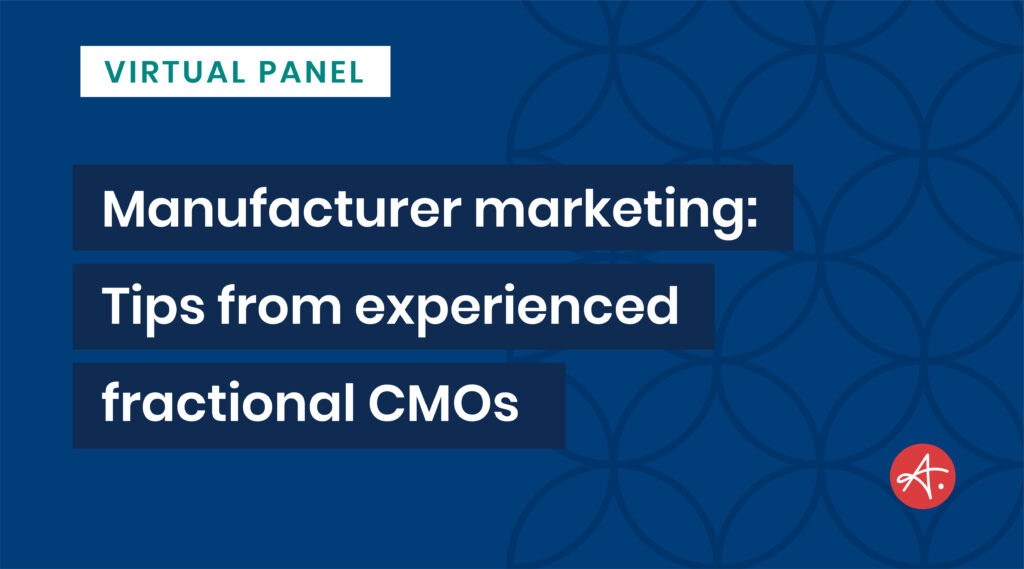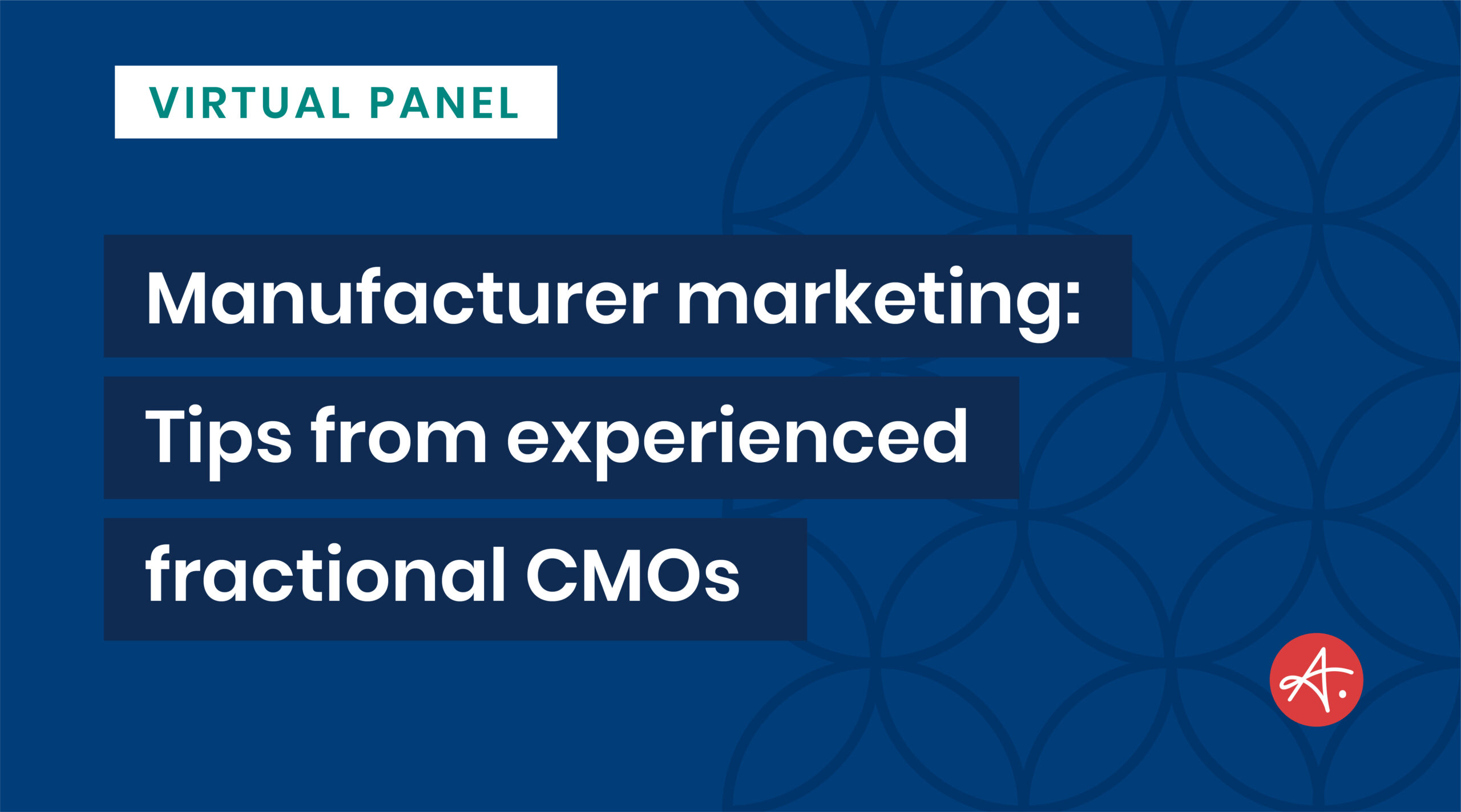
Manufacturer marketing: Tips from experienced fractional CMOs
In the rapidly evolving world of manufacturing and distribution, staying ahead of the curve is vital for survival. With growing competition driven by eCommerce, shifts in consumer behavior, persisting supply chain challenges, talent constraints, and the ever-present digital revolution, marketers must be savvy, strategic, and always ready to adapt.
We invited two Authentic Fractional CMOs™, Christy Joyce and Daneen Kiger, to provide marketing insights and recommendations to growing manufacturers and distributors. They dive into the biggest growth challenges these industries face today, provide advice on essential marketing building blocks, and share their perspectives on effective marketing tactics and the most important metrics for tracking ROI.
- What are the biggest growth challenges that the manufacturing industry is facing today?
Christy: Over the past few years, the eCommerce boom has created unprecedented opportunities for manufacturers. But it has also created an exorbitant increase in competition. Ensuring that a manufacturer’s brand, unique value proposition, and the product they provide stand out to their prospective customers is even more critical to secure sales and grow.
Further, allocating the right (digital) marketing budget is even more important. One manufacturer may have the best product, but if a competitor invests more in their digital marketing campaigns, the first manufacturer will miss the potential sales. For example, a floating dock manufacturer I work with recently launched their first robust paid digital campaign (Google and social) to offset waning sales. In just two weeks, we had 10s of 1000s of impressions geared to our target audience, with dealers coming to us directly attributing sales to the campaigns. These campaigns have also consistently increased our social followers by 300+% week over week.
The current landscape of supply chain challenges, increased inflation causing customers to pull back on spending, and a limited — and costly — talent pool are also significant growth challenges for manufacturers today. Manufacturers are paying up for (marketing) talent but, in many cases, are only getting junior-level experience. Hence, the ROI is less, yet the $s still hit their marketing budgets.
Daneen: The manufacturing industry is currently facing challenges in recruiting and retaining skilled labor due to its scarcity and high turnover rates. To tackle this issue and remain competitive, some manufacturers are exploring alternative solutions such as outsourcing and automation, which often require significant investments. In addition, many manufacturers are adopting innovative recruitment strategies that offer distinctive and comprehensive benefits, accommodate flexible work arrangements, and strongly emphasize ongoing education and development programs for their workforce.
Notably, a recent client of mine has made remarkable progress by prioritizing conversations about continued employee development. This initiative has positively impacted productivity and company culture, with over ninety percent of their employees actively participating in the development program, resulting in reduced turnover rates.
Meeting customer expectations is undoubtedly a significant challenge in the manufacturing industry, given the heightened standards of today’s customers regarding product quality, customization options, delivery speed, and overall experience. To effectively address these expectations, manufacturers must prioritize understanding customer needs and preferences through market research and feedback mechanisms.
Another recent client example of mine illustrates this approach, where the client undertook a customer journey project to understand their customers’ experiences better and align their offerings accordingly. This initiative has led them to embrace updated processes and leverage advanced sales and marketing analytics, enhancing their manufacturing agility and responsiveness to customer demands. By continuously monitoring and meeting customer expectations, manufacturers can build long-term customer loyalty, drive repeat business, and maintain a competitive edge in the market.
- In light of these challenges, what building blocks are essential for manufacturers and distributors to have in place to develop a sound marketing strategy?
Christy: I recommend doing the following:
- Know your target audience intimately. Understand its pain points and work to position yourself to address those at every touch. This not only helps build meaningful relationships but is a wiser budget investment. I’d rather target 100 highly qualified prospects than 10,000 semi-interested prospects.
- Avoid marketing to yourself. Manufacturers love their products and understand them and their industry deeply, but at the end of the day, it’s not about the manufacturer; it’s about the customer. Stay objective and always put yourself in your customers’ shoes to ask hard questions such as “Why would they care?” or “What problem does this solve?”
- Plan, plan, and plan some more to stay focused on your goals to achieve results and grow. Don’t get distracted by the next burst or shiny object.
- Fundamentally have the right talent in the right seats.
- Embrace metrics and data to make sound business decisions.
Daneen: Building on Christy’s recommendations, I also recommend you:
- Clearly define and communicate the unique value that products or services offer customers. This helps customers understand what sets the brand apart from competitors and highlights the key benefits that resonate with the target audience.
- Determine the most effective distribution channels and channel partners to reach target customers. Consider factors such as customer preferences, market reach, and cost-effectiveness in developing a strategic approach to optimizing the distribution network and ensuring efficient product delivery.
- Encourage collaboration between manufacturers and distribution partners to align marketing strategies, share market insights, and leverage each other’s strengths. Develop mutually beneficial partnerships that enhance brand visibility and market reach.
- Implement a robust CRM system to manage customer interactions and nurture long-term relationships. Develop a data-driven approach to marketing by leveraging customer data to personalize marketing efforts, track customer behavior, and identify opportunities for upselling or cross-selling.
- What marketing tactics work well as part of a comprehensive marketing roadmap for manufacturers, and what are the most important metrics for tracking the ROI of their marketing efforts?
Christy: In general, the manufacturers I have worked with have small teams and, in some cases, limited budgets. One of the most important tactics is to create an annual marketing calendar outlining all activities such as events, photo shoots, catalog dates, product launches, social posts, etc., and seasonality as it relates to the business. This proactive planning allows a small team to have foresight into what’s on the horizon to achieve more with less. It also shows peaks and valleys throughout the year, which will help determine if additional staff is needed.
One manufacturer I work with has four unique brands, yet all marketing efforts funnel through one department. With this type of proactive planning, the small team can produce more and feel empowered to push back on requests they have not proactively planned.
The following are also critical to your marketing plan, roadmap, and growth:
- Planning quarterly rocks/goals to keep your (small) team laser-focused,
- Having clear job descriptions and accountabilities, along with the right external resources,
- Knowing which metrics you should track, such as what channel drives the most traffic to a website or what type of social posts generate the most engagement, and
- Using data to understand the customer journey — how are they finding you, interacting with you, buying from you, or falling away from you — for ongoing improvement and growth.
Daneen: Like Christy, as fractional CMOs, we specialize in working with small teams with limited budgets. We immediately dive into understanding the next 90 days while also developing a comprehensive roadmap for the entire year. A key aspect of the roadmap is creating valuable and relevant content that positions our clients as industry experts and builds trust with their target audience. From blog posts and case studies to social media engagement, content remains a top priority. Regular team meetings, at least once a month, ensure alignment and allow for collaborative content planning for the upcoming months, including input from the sales team.
In manufacturing, leveraging social media platforms, particularly LinkedIn, is crucial for direct audience engagement. Establishing a strong social media presence, sharing valuable content, and actively participating in industry discussions enhance brand visibility and increase customer engagement. I strongly emphasize the importance of an employee engagement strategy on social platforms, recognizing it as a valuable aspect of social selling.
Participating in trade shows, exhibitions, and industry events provides manufacturers invaluable opportunities to showcase their products, network with potential customers and channel partners, and generate leads.
When tracking key performance indicators (KPIs) for marketing efforts, we prioritize metrics that align with our clients’ goals and objectives. These include:
- Sales revenue generated from marketing initiatives,
- Customer Lifetime Value (CLV),
- Conversion rates to assess the effectiveness of turning prospects into customers, and
- Website analytics, such as traffic, bounce rate, time on site, and page views, provide valuable insights into user behavior and engagement.
By closely monitoring these metrics, we can make informed decisions, optimize marketing strategies, and ensure our clients’ marketing efforts align with their objectives.
Manufacturers and distributors must adapt and innovate to thrive in the ever-evolving manufacturing landscape. Strategic, agile marketing strategies built on a deep understanding of the target audience, value proposition, and optimized resources are crucial for growth.
Our team of fractional CMOs has deep experience helping manufacturers and distributors understand their marketplace, develop marketing strategies that support business objectives, and build teams that drive success. Let’s connect if you’d like to discuss how an Authentic Fractional CMO™ can help you confidently take the next right step to build revenue and succeed in the manufacturing industry.











